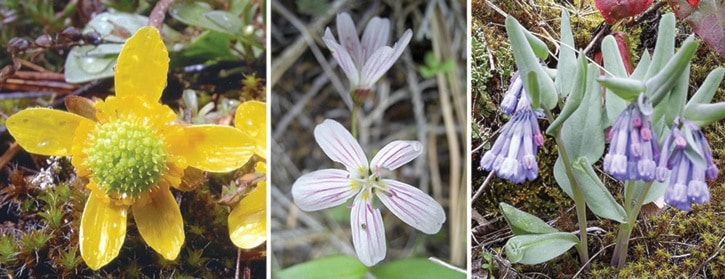There is no particularly detectable aroma wafting from the first three showy, spring flowers to draw oohs and ahs from human voice boxes. But when those little flowers open up, sporting yellow, white and blue, the drab landscape of open slopes becomes alive with spots of colour. The rocky slopes have reached adequate temperatures for growth and bloom.
Several tiny white flowers, a very small chickweed and scale pod opened up earlier in the season, but they are easily missed. One nearly needs a magnifying glass to see them. Willow and hazelnut shrubs also bear flowers earlier in the season. However, not likely to be missed on the south facing exposures are those brilliant yellow, white and blue flower “flags”, although hardly like flags as much as are the later blooming blue flags and yellow flags — that is, the flowers of the iris.
First, under the sheltering and warming backdrop of several ponderosa pines, appeared the bright yellow sagebrush buttercup. Greenish, round buds opened up into greenish and then yellow petals forming a saucer shape surrounding a round centre cluster of 30 or so little nutlike seeds, achenes. These potentially productive seeds begin to enlarge as soon as they are pollinated and, thus, the center of the flower becomes larger than it was initially. Ultimately, the petals leave the seed department and the seeds scatter when mature. Interestingly, despite all those seeds, in subsequent years, I don’t see groups of this ground-hugging buttercup species colonizing nearby. The same numbers seem to appear in the same spots year after year.
The little white saucer-shaped flower of spring beauty is certainly a beauty. But note, it is not always white but may be varying shades pink right to a soft dark pink, where the characteristic pink veins blend into the background of the five petals. I haven’t found an explanation for this colour variation. Some suggest it may depend on the soil nutrients available.
The third showy spring flower that I often see is not as showy as far as bright colours go, but its blue and pinkish flowers, an uncommon combination among wildflowers, are sure to attract attention. The mountain bluebell (lungwort) does best in rock-enclosed pockets of soil on slopes or ledges of south-facing exposures. Like sagebrush buttercup and spring beauty, they thrive in rich soils moistened by spring melt. By midsummer, the moisture available to the shallow, soil-covered bedrock slopes declines dramatically and most evidence of the sagebrush buttercup, spring beauty and this dwarf mountain bluebell completely disappear.
The nodding mountain bluebell flower, if envisioned pointing upward, reminds me, in colour and shape, of the smooth gentian, a high elevation species in our Kootenay mountains.
Now the same blooming sequence of sagebrush buttercup, spring beauty and the mountain bluebell does not occur on every south exposure. Depending on the character of the slope and the soil type, the species and the blooming sequence can vary. On some slopes, the initial sequence might be yellow glacier lily, spring beauty and then, perhaps, purple ballhead waterleaf. Also, the presence of low shrub cover may advance the blooming time of, say, yellow glacier lily by a “greenhouse” effect. The shrubby enclosures provide shelter from the wind thus retaining warmth and moisture, bringing flowers into earlier blooming.
When the bluebells reach peak blooming, it is possible to find yellow bells (yellow fritillary) and other later species beginning to bloom nearby. The six-inch yellow bells, a member of the lily family, support one or two rich orange-yellow blooms that, in bell fashion, hang downward.
Now, you may have already seen some of our early, showy spring flowers or may see them shortly; however if you have missed them, go by trail or road just a little higher up where spring comes a bit later, and you may get to see a second showing. And, if you are out of the area check out the south Okanagan for the spring blooming chocolate lily, another fritillary.
Ed McMackin is a biologist by profession but a naturalist and hiker by nature. He can be reached at 250-866-5747.
